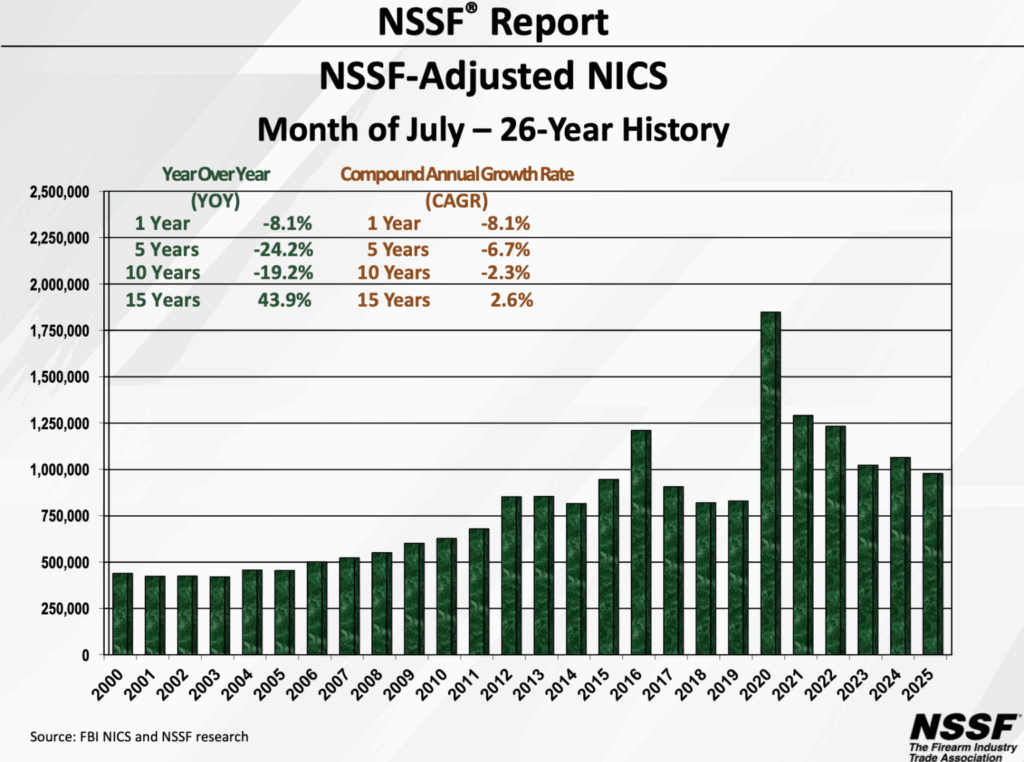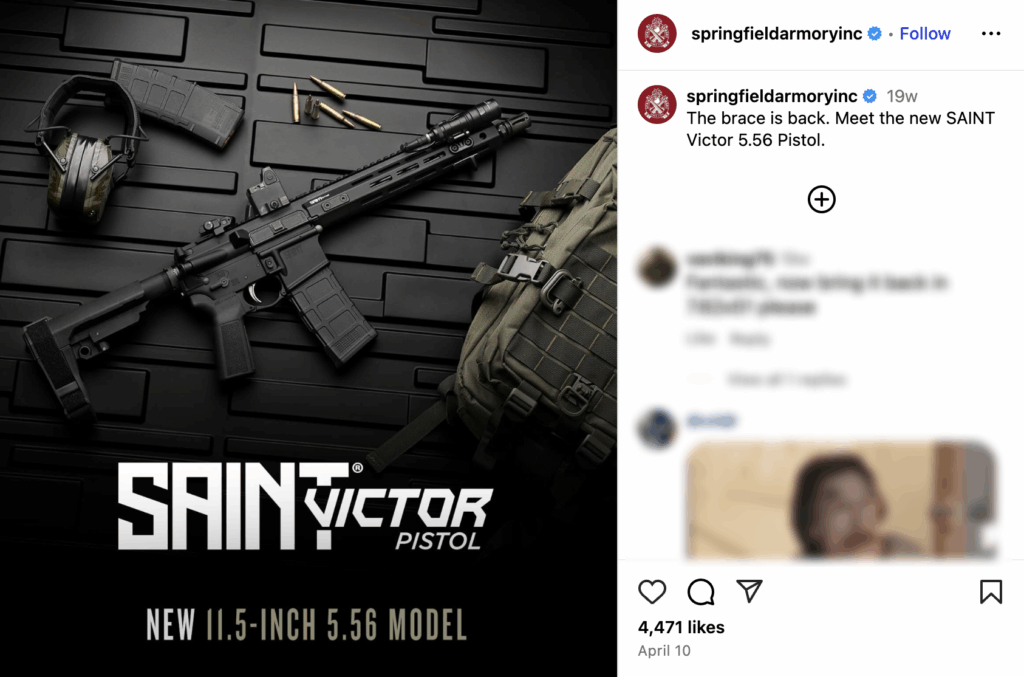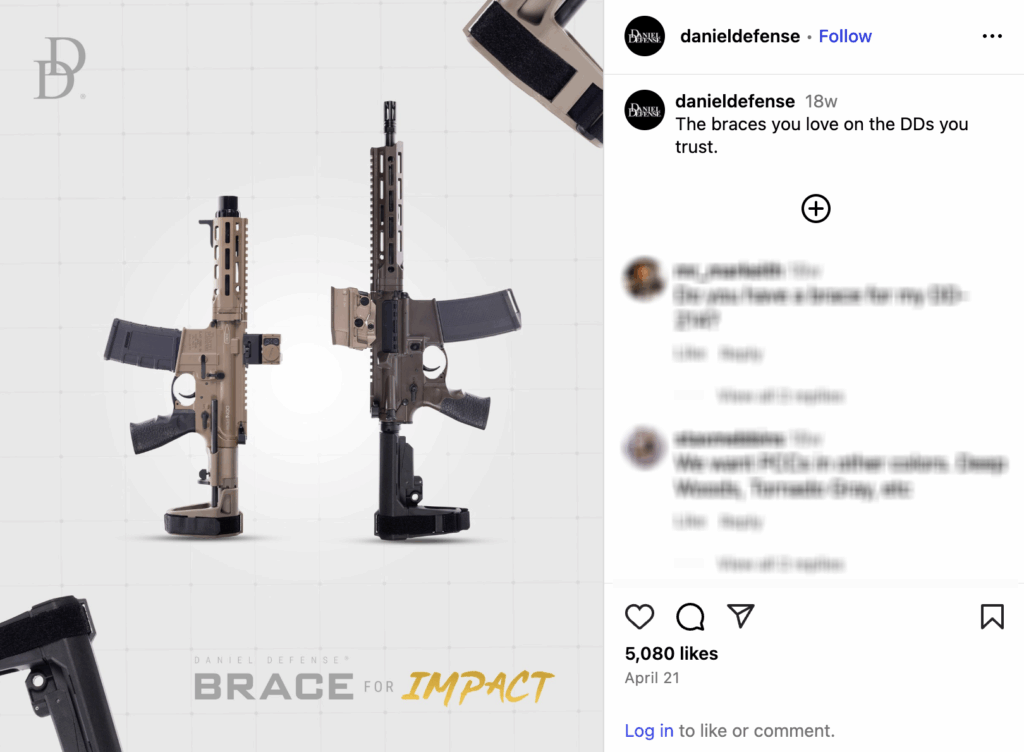For the first time in nearly six years, estimated monthly gun sales in the United States fell below 1 million. According to the National Shooting Sports Foundation (NSSF), the gun industry’s trade association, there were 978,731 background checks conducted for firearms at retail — a rough proxy of gun sales — in July 2025, ending a 71-month streak that began in July 2019. The figure marks an 8.1-percent drop from July 2024 and follows a 5.1-percent year-over-year decline in June.1The FBI publishes the total number of National Instant Criminal Background Check System (NICS) background checks processed each month. The NSSF adjusts the figure by subtracting out NICS checks used for concealed-carry permit applications and re-checks.

The streak was fueled by pandemic panic-buying, social unrest, and the gun industry pushing a narrative that the Biden administration was a threat to gun rights.
Responding to the decline in gun sales, the NSSF’s managing director of public affairs, Mark Oliva, said, “Summer months routinely show lower background check figures than other times of the year.” But he also blamed the decline on “relief of concern that politics would deny some from being able to exercise Second Amendment rights to purchase a firearm of one’s choice and economic uncertainty.”
In other words, the gun industry can’t scare people into thinking the government is going to confiscate firearms, as it tried with President Biden.
Trump administration handouts
Facing slower sales and tariffs, the gun industry and its backers have turned their efforts towards Capitol Hill and the White House to subsidize sales. The strategy: roll back regulations, reduce Bureau of Alcohol, Tobacco, Firearms and Explosives (ATF) oversight, and expand where people can carry firearms.
In July, President Trump signed into law the “One Big Beautiful Bill Act,” containing a provision repealing the $200 taxes required to purchase or make silencers, short-barreled rifles and shotguns, and “any other weapon” (AOW) regulated by the National Firearms Act (NFA), making it easier for people to obtain these dangerous — and once highly regulated — items. The background checks, fingerprinting, and paperwork required under the NFA remain, but the taxes that had been in place since 1934 will no longer be required as of January 1, 2026. For the industry, it was a long-sought-after win that makes these items cheaper and easier to buy. For the government, it’s a projected $1.7 billion loss in revenue over the next decade.
In 2016, the NSSF secured a rule change that eliminated the need for local law enforcement signoff on NFA items, replacing it with a simple notification. The NSSF also lobbied for the Bureau of Alcohol, Tobacco, Firearms and Explosives (ATF) to deploy a revamped online application system for NFA items in 2021, leading to dramatically faster approval times and corresponding surge in sales.
Further undercutting the NFA, the Trump administration effectively legalized forced-reset triggers, which allow semi-automatic rifles to fire like machine guns, and signaled that it will stop defending the Biden administration’s arm brace rule in court, making it easier for gun makers to resume selling short-barreled AR-15 “pistols” with arm braces — like the kind used in the recent mass shooting in New York City — while avoiding NFA registration requirements for short-barreled rifles.


reducing atf oversight
Additionally, the second Trump administration has ushered in a “New Era of Reform” at the ATF that limits the agency’s ability to oversee the gun industry and stop illegal gun sales. Since Trump took office, the administration has:
- Rescinded the “zero tolerance” policy of revoking the licenses of gun dealers who willfully violated federal law;
- Announced that the gun dealers who had their licenses revoked under that policy may reapply and issued internal guidance instructing ATF personnel to be more lenient during inspections;
- Expanded the list of state permits qualifying as “Brady alternatives,” enabling more gun buyers to bypass federal background checks;
- Made it harder for ATF agents to receive alerts when suspected straw purchasers or gun traffickers attempt to buy firearms from dealers; and
- Ended a 25-year-old program that the ATF used to identify and monitor the gun dealers who sold the most crime guns across the country.
concealed carry drives sales
Despite having research showing that concealed-carry “makes Americans feel less safe,” the NSSF is also leaning on Congress to pass the Constitutional Concealed Carry Reciprocity Act. The bill would override state laws and make it so anyone allowed to carry in one state — whether that state requires a concealed-carry permit or not — to carry in any other state, even in those with stricter regulations where they otherwise wouldn’t be allowed to carry.
For the industry, it’s an opportunity to unlock new markets, driving sales of concealable firearms, holsters, and gear. One of the NSSF’s market research studies found that “the more frequently someone carries a handgun the more they tend to spend on handguns, ammunition and accessories.”
The over-1-million-gun-sales-per-month streak was an anomaly fueled by extraordinary circumstances. Now, the industry is looking to Congress and Trump to bolster its bottom line.